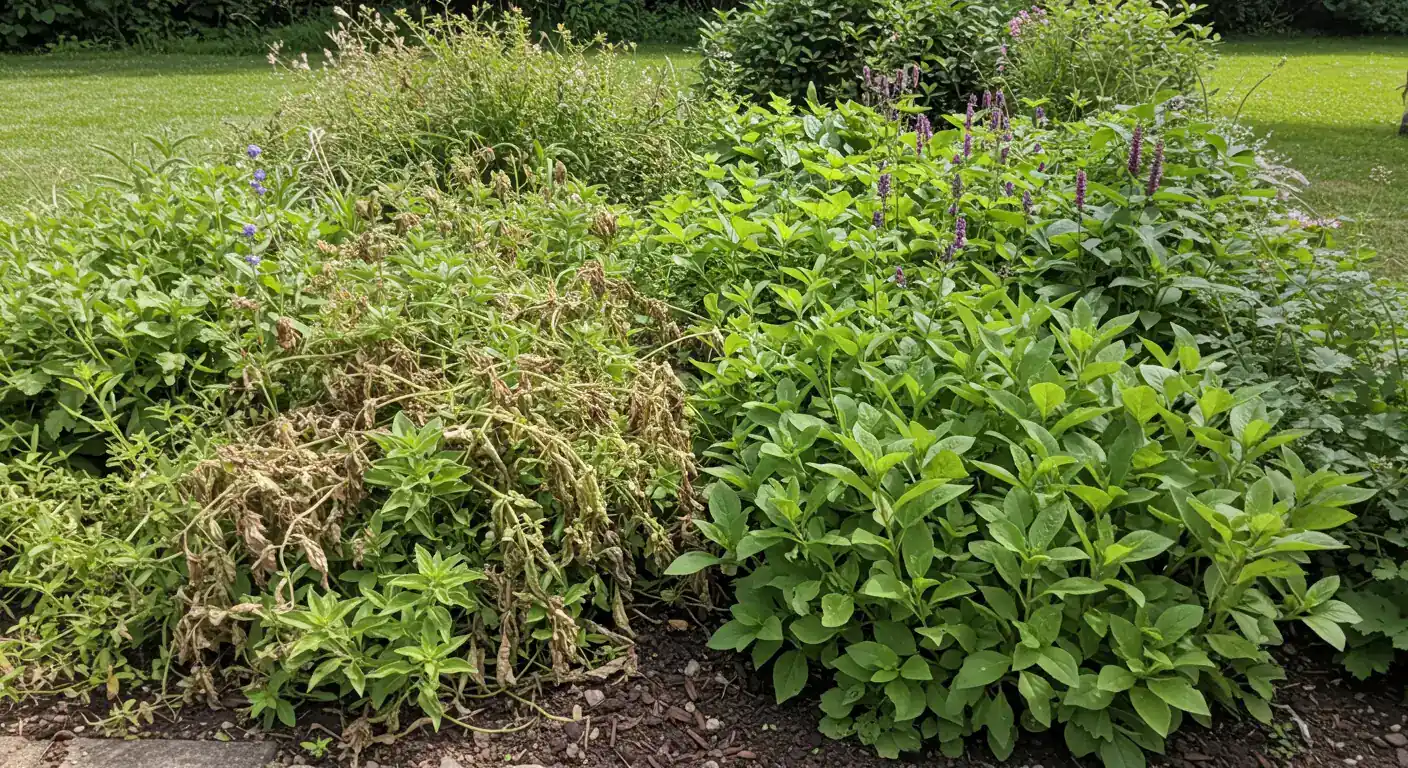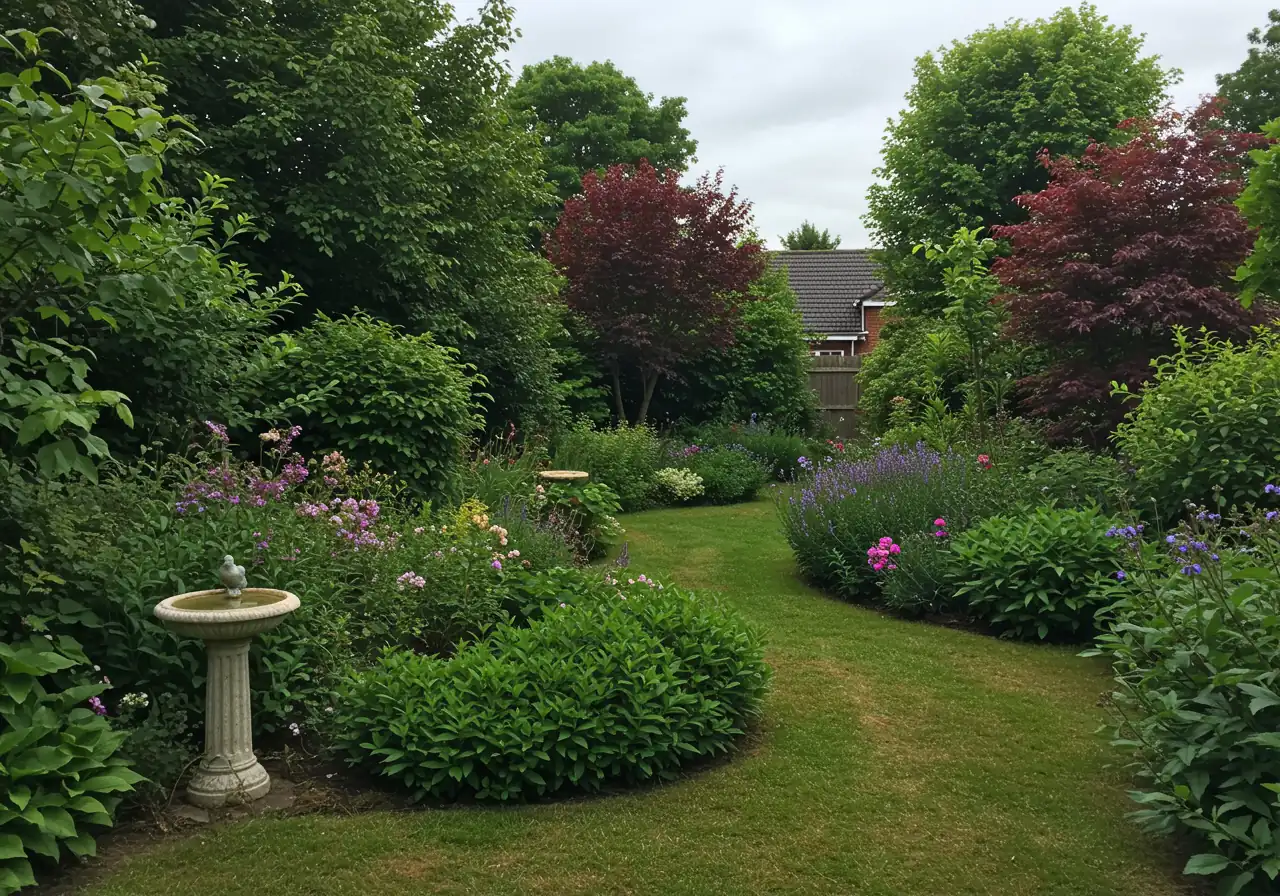Proper Kars Garden Spacing: Avoid Summer Plant Chaos
Quick Guide to Garden Spacing:
- Proper spacing prevents overcrowding, promoting healthier plants.
- Good airflow reduces fungal diseases common in Ottawa's humidity.
- Plants get adequate sunlight, water, and nutrients without intense competition.
- Spacing simplifies maintenance like weeding and watering.
- Always space according to the plant's *mature* size, not its current size.
- Consider Ottawa's climate and soil type when planning layouts.
Planning your Kars garden? Ensure your plants have the room they need to thrive! Proper spacing is key to preventing a tangled summer mess. Need help getting it right? Request a free quote today!
Introduction: Taming the Tangle - Why Your Kars Garden Needs Proper Spacing

Remember last summer? Your beautiful perennials started out looking so neat, but by August, did it feel like a botanical free-for-all broke out in your flower beds? Maybe your tomatoes staged a slightly *too* enthusiastic takeover of the poor peppers? We've all seen (or created!) that garden chaos. That tangled jungle look isn't just messy landscaping; it's often a sign our plants are literally fighting for sunlight, water, and nutrients.
Welcome to the secret weapon of serene, successful gardens: proper spacing! Especially here in Kars, where our unique Ottawa Valley climate gives plants a real journey through the seasons, giving them the right amount of breathing room is crucial. Think of it like polite dinner guests – everyone thrives with a little personal space. Getting spacing right means healthier, more robust plants, fewer disease and pest problems (they love crowded conditions!), much easier maintenance and weeding (hooray!), and boosted curb appeal that might even impress folks over in nearby Osgoode. Need help visualizing? Check out our garden transformations.
It takes a bit of foresight, but trust us, taming that tangle is the key to a garden that truly flourishes. Let's dig into why giving your plants room to grow is the best investment you can make in your beautiful Kars garden. We'll explore how to figure out the right distances and why a little space goes a long way towards a happy, healthy landscape. For insights specific to other nearby areas, consider reading about Metcalfe garden clean up or Marionville garden services.
More Than Just Elbow Room: The Science Behind Smart Spacing

It’s tempting, isn't it? You get excited at the garden centre, bring home a carload of botanical beauties, and want to pack them all in for that instant lush look. But hold your trowel! Giving plants the right amount of space isn't just about looks; it's crucial for their health and happiness, especially with Ottawa's unique climate swings. Think of it as respecting their personal bubble – they'll thank you for it later!
So, what's the big deal about spacing?
- Let the Air Flow: Remember those muggy Ottawa summer days? Plants feel it too! Crowded conditions trap moisture between leaves, creating a perfect party spot for fungal diseases like powdery mildew. Good airflow helps leaves dry quickly, preventing these unwelcome guests. Proper spacing means healthier foliage and less disease management down the road, making tasks like a thorough Nepean commercial fall cleanup much simpler as there's less diseased material to remove. For more localized cleanup info, see Ottawa yard cleanup or Metcalfe yard cleanup.
- Sunshine Hogs vs. Sharing is Caring: Plants need sunlight like we need coffee (or maybe tea, if you prefer!). When they're crammed together, taller or faster-growing plants hog all the rays, leaving their neighbours struggling in the shade. Proper spacing ensures everyone gets their fair share of sunlight for photosynthesis, leading to stronger stems, more flowers, and better veggie yields.
- The Underground Battle: Below the surface, plant roots are locked in a silent competition for water and nutrients. Packing plants too tightly means intense root rivalry. This is especially important in areas like Manotick or Greely where clay soil can sometimes make it harder for roots to penetrate and access resources. Giving roots room to spread reduces this competition. Promoting good soil structure is also key; you can learn more about understanding the importance of soil health and how it complements proper spacing. Explore our soil preparation services for assistance.
- Strong Roots, Strong Plants: Speaking of roots, when they have space to explore, they grow deeper and wider. This creates a much stronger anchor for the plant and makes it more resilient to drought and those wild Ottawa weather fluctuations. Well-established root systems are vital for survival, forming the foundation discussed in these essential Russell winter plant protection prep tips.
- Easier Access for You (and Us!): Let's be honest, weeding, fertilizing, or even just admiring your plants is much harder when you're navigating a dense jungle. Good spacing makes maintenance a breeze. It allows you, or your friendly garden helpers like those found on our Google Business Profile, to get in there without damaging neighbouring plants. This definitely makes tasks like getting your garden ready in the spring easier, simplifying efforts like a Barrhaven commercial spring cleanup or making your annual Winchester garden clean up service far more efficient.
Quick Tip: Always check the plant tag! It tells you the mature size of the plant. Space according to that future size, not the tiny pot it came in. It might look a bit sparse initially, but patience pays off with healthier, happier plants that truly fill their space beautifully. Need help planning your garden layout or with ongoing garden maintenance? Feel free to explore our full range of landscaping services.
Know Your Plants: Decoding Size, Needs, and Neighbours
Alright garden enthusiasts, let's chat about getting personal – with your plants! Just like people, every plant has its own personality, preferences, and, yes, needs. Shoving a sun-loving diva into a shady corner or asking a drought-tolerant tough guy to swim in soggy soil is a recipe for botanical blues. Understanding what each plant requires is key to creating a happy, harmonious garden landscape, whether you're in Greely or anywhere else across Ottawa.
The Plant Tag: Your Cheat Sheet
First things first: that little tag stuck in the pot? It's not just for the price! It’s your primary source of intel. Look for the mature size – how big will this little guy actually get? Remember our chat about spacing? You need to plan for the full-grown version, not the baby you brought home. Ignore this, and you'll be refereeing plant wrestling matches by mid-summer. Also, note the growth habit. Is it upright like a soldier, spreading like gossip, or vining like it's trying to escape? This tells you how it will fill its space. See examples in our project gallery.
Decoding Needs: Sun, Water, and Soil
Beyond size, the tag (or a quick online search) reveals crucial needs:
- Sun Exposure: "Full sun" usually means 6+ hours of direct sunlight daily. "Part sun" or "Part shade" typically means 4-6 hours, often preferring morning sun. "Full shade" means less than 4 hours, tolerating dappled light or bright indirect light. Matching the plant to the sunlight in a specific spot in your yard is non-negotiable for good *gardening* results. An east-facing wall in Manotick gets different sun than a south-facing open space! Consider local resources like the City of Ottawa Tree Planting information for understanding sunlight patterns.
- Water Requirements: Is your plant a "drought-tolerant" warrior that shrugs off dry spells, or does it prefer "consistently moist" soil? Grouping plants with similar water needs makes watering routines much simpler. Plants that prefer consistently moist soil really benefit from techniques like proper mulching and edging to conserve water around their roots.
Friendly Neighbours: Intro to Companion Planting
Did you know some plants can actually help each other out? This is called companion planting. It's like finding the perfect seating arrangement at a dinner party – some guests just bring out the best in others! Certain plants can deter pests, attract beneficial insects, or even improve the flavour or growth of their neighbours. It's a fantastic natural *landscaping* strategy.
For example, planting marigolds near tomatoes is a classic Ottawa gardener trick; the marigolds' scent can help repel pests like nematodes and tomato hornworms. Here are a few simple ideas:
| Plant A (Primary) | Plant B (Companion) | Benefit |
|---|---|---|
| Tomatoes | Marigolds, Basil | Deters pests (nematodes, hornworms, flies) |
| Carrots | Rosemary, Sage | Deters carrot rust fly |
| Cabbage/Broccoli | Dill, Chamomile | Attracts beneficial insects (wasps) |
| Cucumbers | Nasturtiums, Radish | Deters cucumber beetles, aphids |
Taking the time to understand these individual plant needs prevents future headaches and wasted effort. It avoids overcrowding, making seasonal tasks like our popular Winchester garden clean up service much smoother. Our team, detailed further on the About Us page, considers all these factors when planning garden designs or maintenance. And like any good partnership, understanding expectations is key; you can always review our service details in the Terms and Conditions or our Privacy Policy. Feeling a bit overwhelmed? Don't worry! You can always contact us for personalized advice – we genuinely look forward to hearing from you and eventually saying Thank You for trusting us with your garden! Perhaps you've already worked with us? We appreciate your feedback.
Mapping Your Masterpiece: Spacing Strategies & Layouts
Okay, you’ve figured out why your plants need space, and you know what each plant needs. Now for the fun part: arranging them like puzzle pieces into a beautiful, functional garden picture! This is where we move from individual plant needs to the bigger picture – the layout of your garden beds. Think of it as garden choreography; you want everyone moving gracefully, not bumping into each other! Let's map out some strategies that work brilliantly here in Ottawa.
Traditional Rows: The Straight Shooter
This is the classic farmer's field look – neat rows with pathways in between.
- Principles: Plants are spaced along straight lines, leaving ample room between rows for walking, weeding, and maybe even a small tiller.
- Pros: Excellent air circulation, easy access for maintenance (especially with tools), simple to plan. It's straightforward *gardening*.
- Cons: Can be space-inefficient as paths take up considerable room. Might look a bit formal or rigid for some *landscaping* tastes.
- Best for: Larger vegetable gardens where efficiency and access for cultivation are key. Think of those sprawling market gardens you might see out near Richmond.
Block Planting: Cozy Clusters
Instead of single file lines, you group plants together in wider blocks or beds.
- Principles: Plants are spaced equidistantly within a defined bed, often accessible from all sides. Think triangles or hexagonal patterns within the block for maximum density.
- Pros: Uses space much more efficiently than rows, creates a lush, full look faster, can suppress weeds within the block once plants mature, looks great in flower beds. Very popular in suburban yards like those in Barrhaven.
- Cons: Reaching the middle of very wide blocks (more than 4 feet) can be tricky without stepping into the bed. Need clear pathways *around* the blocks.
- Best for: Flower beds, perennial gardens, and moderately sized vegetable patches where maximizing yield per square foot is desirable.
Square Foot Gardening (SFG): Maximum Impact, Minimum Space
This method uses raised beds, typically 4x4 feet, divided into a grid of 1x1 foot squares.
- Principles: Each square foot is intensively planted based on the mature size of the specific plant (e.g., 1 tomato per sq ft, 4 lettuces, 9 bush beans, 16 carrots). It relies on rich, loose soil.
- Pros: Highly productive, extremely space-efficient, minimizes weeds, conserves water, makes planning easy (just count squares!). Fantastic for beginners or those with limited space.
- Cons: Requires initial setup effort and cost for building beds and creating the special soil mix.
- Quick SFG Planning:
- Build or buy a raised bed (max 4 feet wide for reach).
- Divide the surface into a 1x1 foot grid (use string, wood strips, etc.).
- Decide what to plant, checking SFG guides for plants-per-square.
- Map it out! Put taller plants on the north side so they don't shade shorter ones.
- Fill with a quality soil mix – ensuring excellent soil structure through proper soil preparation is absolutely crucial for SFG success.
Vertical Gardening: Reaching for the Sky!
Think up, not just out! Use trellises, fences, walls, hanging baskets, or specialized vertical planters.
- Principles: Training vining plants upwards or using stacked containers to grow in a vertical plane.
- Pros: Saves huge amounts of ground space, ideal for balconies, patios, or small Ottawa yards. Adds visual height and interest. Can make harvesting easier for some crops.
- Cons: Requires sturdy supports. Plants might dry out faster and need more frequent watering. Limited to vining/climbing plants or smaller varieties suitable for containers.
- Best for: Small spaces, growing vining fruits and vegetables (cucumbers, beans, peas, tomatoes, some melons), herbs, and decorative annuals.
Which Way to Go?
There's no single "best" way – it depends on your space, time, and goals! Often, a mix works well. Maybe rows for corn, blocks for flowers, and a vertical section for cucumbers. Planning your layout *before* undertaking major work like a fresh sod installation nearby is smart, ensuring garden beds don't interfere. Remember, clearing the area is the first step, much like our Metcalfe property cleanup service (or broader Ottawa property cleanup) prepares a site for transformation.
Experiment, see what you like, and don't be afraid to change things next season. You can check out our gallery of garden transformations for inspiration on how different layouts look in real Ottawa yards. And if mapping it all out feels like too much homework, you can always leave the heavy lifting of a new professional garden install to us. We'd love to say Thank You for considering our help in creating your garden masterpiece!
The Ottawa Factor: Adapting Spacing for Our Climate and Soil
Okay, fellow Ottawa green thumbs, let's talk about gardening in our neck of the woods. We all know Ottawa throws a few curveballs at our plants – a blink-and-you'll-miss-it growing season, summers that can feel like a sauna, and soil that varies wildly from one neighbourhood to the next. Adapting your plant spacing to these local quirks is key to a garden that doesn't just survive, but thrives! Find local advice from resources like the Friends of the Central Experimental Farm.
First off, that short growing season means our plants are in a race against time. Giving them proper space right from the start reduces competition for sunlight, water, and nutrients, allowing them to establish roots and grow faster. Think of it like giving them a head start before that first hint of fall frost arrives, often around Thanksgiving. Crowded plants are stressed plants, and stressed plants grow slower – not ideal when the clock is ticking!
Then there's our summer humidity. Remember those muggy July days? Plants feel it too! Jamming them together creates pockets of stagnant, moist air – basically, a VIP lounge for fungal diseases like powdery mildew. Good airflow, achieved through smart spacing, helps leaves dry out, keeping diseases at bay. This makes ongoing maintenance easier and ensures less diseased material needs removing during your big end-of-season overall property clean-up.
Our soil adds another fun layer. Drive from Manotick, with its heavier clay that holds moisture (sometimes too well!), over to areas like Metcalfe or Greely, and you might find much sandier soil that drains like a sieve. Check Agriculture Canada's soil resources for general information.
- Clay Soil: Needs slightly wider spacing to prevent roots from sitting in waterlogged conditions and encourage air circulation around the base of plants. Adding organic matter helps improve drainage.
- Sandy Soil: Plants might need slightly closer spacing (but still follow tag guidelines!) to help shade the soil and conserve moisture, or wider spacing to allow roots to spread far and wide searching for water. Amending with compost is crucial here too. Choosing the right amendments and mulches is part of thoughtful landscape material selection, helping plants cope with the native soil.
Good spacing also supports eco-friendly watering. When roots have room to grow deep, they become more drought-tolerant, needing less frequent watering. Instead of light, daily sprinkles (which encourage shallow roots), you can water deeply less often, knowing the moisture is getting where it needs to go. This contrasts with lawn needs, where consistent moisture is often key for that lush green look achieved through dedicated professional lawn care services.
Spring (May-June)
Plan layout *before* planting. Check mature sizes! Consider help with a new garden bed installation. Plant after last frost risk (Victoria Day target!).
Summer (July-August)
Observe growth. Notice crowding? Minor thinning might be needed. Enjoy the blooms and evaluate spacing effectiveness.
Fall (September-October)
Evaluate what worked. Note adjustments for next year. Crucial before/during fall tidy-up, like our Metcalfe garden clean up service, to prep beds for winter.
Paying attention to these Ottawa-specific factors when spacing your plants might seem like extra homework, but it pays off with healthier plants, easier maintenance, and a garden that truly shines, even with our challenging climate!
Example: Reduced Disease Incidence with Proper Spacing
*Illustrative data representing potential reduction in fungal disease reports.
Quick Tips: Spacing Sanity Savers
- Read the Tag, Trust the Tag: Seriously, that little plastic tag is your best friend. Always space plants based on their *mature* size listed there, not how cute and small they look now. Future you will appreciate not having a botanical battle royale in your Barrhaven backyard.
- Air is Your Ally: Remember our humid Ottawa summers? Giving plants room to breathe allows air to circulate, drying leaves faster and reducing the risk of annoying fungal diseases. Happy plants, less *landscaping* stress!
- Think 'Easy Access': Space plants so *you* can comfortably weed, water, and admire them without performing Cirque du Soleil contortions. This simplifies everything, especially regular ongoing garden maintenance.
- Future Mess Prevention: What starts crowded only gets *more* crowded. Proper spacing now prevents a tangled mess later, avoiding the need for a drastic intervention like a full Marionville yard cleanup service when a targeted approach like our Marionville garden clean up service could have sufficed. You can also check our general property clean up services.
- Plan it Out (or Get Help!): Sketching your *spacing* plan first helps visualize the end result. If mapping your masterpiece feels daunting, don't hesitate to book a free estimate online for professional advice. We handle your details responsibly, as outlined in our site privacy policy.
Ottawa Garden Spacing FAQs: Your Questions Answered
Great question! Clay soil, common in areas like Nepean or parts of Manotick, holds water really well – sometimes *too* well. It's smart to give plants slightly *wider* spacing than the tag might suggest. This boosts air circulation around the base and roots, reducing the risk of rot. Improving the soil structure before planting is also key. Sometimes getting the site fully prepped might involve a broader comprehensive Ottawa property cleanup service to properly amend the soil.
You bet! Because our plants are racing against the clock before fall frost arrives, giving them *proper* spacing right from the start is crucial. Less competition for sunlight, water, and nutrients means faster, healthier growth. Crowded plants grow slower! Think of proper spacing as giving them a head start. Preparing your yard well each season with a thorough general Ottawa yard cleanup service really sets the stage for success.
Okay, deep breaths! It happens to the best of us. For this season, focus on keeping things tidy, removing any diseased leaves immediately to improve airflow, and watering carefully at the soil level. You might need to plan on carefully thinning out or transplanting some less-favoured plants *next* spring for better long-term health. If it feels like a jungle takeover, consider booking an expert Ottawa garden clean up service to help strategize and tidy things up.
Yes, there's a key difference. Annuals live their whole life in one season, so you space them based on the size they'll achieve by mid-summer. Perennials come back year after year and usually get bigger over time. You need to space perennials based on their *mature* size (often 3-5 years down the road). It might look a bit sparse at first, but trust us, it prevents future plant wrestling matches! Managing these returning favourites is simpler with ongoing maintenance plans, easily viewed through our secure customer portal.
It sure does! Plants with enough space develop stronger, more extensive root systems, which helps anchor them against frost heave and access moisture during dry winter spells. Good air circulation during the growing season also means healthier, more robust plants going into the winter, making them less susceptible to cold damage. It’s all part of setting them up for success, similar to how our detailed Marionville property cleanup service ensures properties across the region are ready for whatever the next season brings.
Conclusion: From Chaos to Calm - Enjoy Your Kars Garden Oasis

Whew! We've journeyed from tangled messes to thoughtful spacing, and hopefully, you're feeling inspired, not overwhelmed. Remember that feeling of garden chaos we talked about? By giving your plants the right elbow room, you're actively choosing calm instead. No more refereeing tomato vs. pepper wrestling matches in your Kars backyard! Proper spacing truly is the secret sauce for successful *gardening*.
Think about it:
- Healthier Plants: They can literally breathe easier with better airflow, cutting down on those pesky diseases that love our humid Ottawa summers.
- Easier Care: Weeding, watering, and just enjoying your plants becomes a breeze, not an obstacle course.
- Happier Roots: They get the water and nutrients they need without a battle, even in challenging local soils like the clay you might find over near Manotick.
Planning for that mature size might seem like you’re leaving empty space now, but trust us, it prevents future headaches and creates a balanced, sustainable *landscaping* picture. You’re setting the stage for a garden that doesn’t just survive our unique climate, but thrives in it, becoming your very own beautiful, stress-free Kars oasis. It's about working smarter*, not harder, to achieve that lush look you love.
Ready to ditch the chaos for good?
- Let us help you map it out! Book your free, no-obligation estimate today and let's discuss your garden vision.
- Got questions or need tailored advice for your space? Reach out and contact our friendly team!
- Find daily inspiration and seasonal tips by following us on social media! (Link would go here if provided)
Happy gardening!

